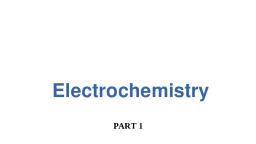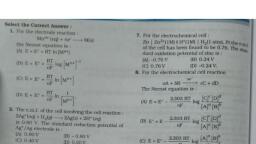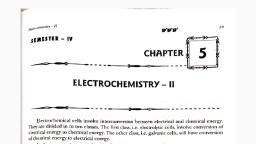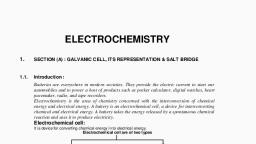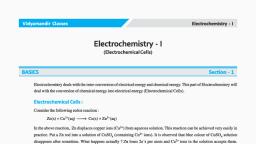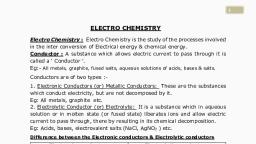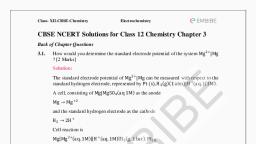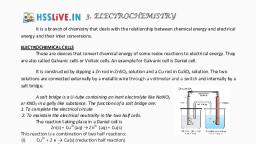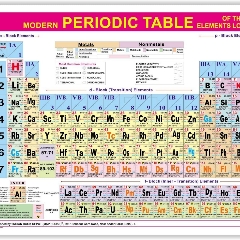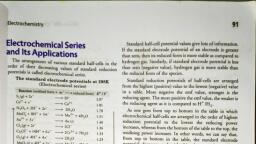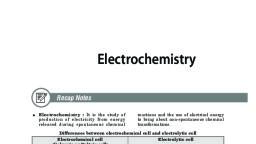Page 3 :
Electrochemistry is the study of, production of electricity from energy, released during spontaneous chemical, reactions, and, the use of electrical energy to bring, about non-spontaneous chemical, transformations., , YS Classes
Page 4 :
Electrochemical Cells /Galvanic, cells /voltaic cell:, It is a cell in which electricity is, produced by a spontaneous reaction., E.g. Daniell cell, , Electrolytic cell:, It is a device used to carry out nonspontaneous chemical reactions using, electricity., , YS Classes
Page 8 :
In a galvanic cell, the half-cell in which, oxidation takes place is called anode, and it has a negative potential with, respect to the solution., The other half-cell in which reduction, takes place is called cathode, and it has a positive potential with, respect to the solution., , YS Classes
Page 9 :
SALT BRIDGE, Salt bridge is a U -shaped tube containing a, semi solid paste of some inert electrolyte, like KCl, KNO3,NH4Cl .... in agar agar or, gelatin, Functions, 1. It allows the flow of current by, completing the circuit, 2. It maintains the electrical neutrality, , YS Classes
Page 10 :
Electrode Potential, The tendency of a metal to lose or gain, electron when it is in contact with its own, solution is called electrode potential, A potential difference develops, between the electrode and the, electrolyte which is called, electrode potential., , YS Classes
Page 11 :
Electrode Potential, When the concentrations of all the, species involved in a half-cell is, unity then the electrode potential is, known as standard electrode, potential., According to IUPAC convention,, standard reduction potentials are, now called standard electrode, potentials., , YS Classes
Page 12 :
Cell Potential, The potential difference between the two, electrodes of a galvanic cell is called the, cell potential and is measured in volts., The cell potential is the difference, between, the, electrode, potentials, (reduction potentials) of the cathode and, anode., It is called the cell electromotive force, (emf)of the cell when no current is, drawn through the cell, , YS Classes
Page 13 :
Cell Potential, The emf of the cell is positive and is, given by the potential of the half-cell, on the right hand side minus the, potential of the half-cell on the left, hand side, i.e., , Ecell = Eright – E, , left, , Ecell = Ecathode– Eanode, , YS Classes
Page 14 :
Representing a cell, the anode is kept on the left and the, , cathode on the right, In anode metal is represented first, followed by metal ion, In cathode metal ion is represented, first followed by metal, put a vertical line between metal and, metal ion, a salt bridge is denoted by putting a, double vertical line, , YS Classes
Page 15 :
Representing a cell, Daniell Cell, , Zn, , (s), , + Cu, 2+, , 2+, , (aq), , –, + 2e, , Zn (s) → Zn, 2+, –, Cu, + 2e → Cu (s), , → Zn, , 2+, , (aq), , + Cu, , (s), , (oxidation half reaction), (reduction half reaction), , The cell can be represented as:, , Zn(s)|Zn, , 2+, , (aq) || Cu, , 2+, , (aq)| Cu(s), , YS Classes
Page 17 :
Effect of opposing potential on the cell reaction, , YS Classes
Page 18 :
Effect of opposing potential on the cell reaction, , YS Classes
Page 19 :
Effect of opposing potential on the cell reaction, , YS Classes
Page 21 :
Measurement of Electrode Potential, The potential of individual half-cell cannot be, measured., We can measure only the difference between the two, half-cell potentials that gives the emf of the cell., For this purpose a half-cell called, Standard HydrogenElectrode (SHE) or, Normal Hydrogen Electrode (NHE) is used., , YS Classes
Page 22 :
Standard HydrogenElectrode (SHE), It consists of a platinum, electrode coated with, platinum black., The electrode is dipped in an, acidic solution of one molar, concentration, and, pure hydrogen gas at 1 bar, pressure and 298K is, bubbled through it., By convention, the electrode potential of SHE is taken as zero., , YS Classes
Page 27 :
Electrochemical series, , It is a series in which various electrodes are, arranged in the increasing order of their, reduction potential, , YS Classes
Page 28 :
•, , The more positive E0 the, greater the tendency for, the substance to be, reduced, The half-cell reactions are, reversible, , •, , The sign of E0 changes, when the reaction is, reversed, , •, , Changing the, stoichiometric, coefficients of a half-cell, reaction does not change, the value of E0, , YS Classes
Page 29 :
Applications of Electrochemical series, , 1.Comparing the relative oxidising and, reducing powers, Substances with higher reduction potentials are strong, oxidising agents, Fluorine has the highest electrode potential thus, Fluorine gas is the strongest oxidising agent, Substances with lower reduction potentials are strong, reducing agents, Lithium has the lowest electrode potential thus, lithium metal is the most powerful reducing agent, in an aqueous solution, , YS Classes
Page 32 :
Fig 18-14, , Pg 877, , The copper/zinc electrochemical cell. The voltmeter measures the, difference in electrical potentials between the two electrodes., , YS Classes
Page 34 :
Applications of Electrochemical series, , 4. Predicting the capability of a metal to, displace hydrogen from dilute acids, , Metals having negative reduction potential, can displace hydrogen from dilute acids, Eg ;- Zn , Mg.., , YS Classes
Page 35 :
NERNST EQUATION, It relate the electrode potential of an electrode (or,emf, of a cell ) with the concentration of electrolytic, Mn+(aq) + ne-, , M(s), , R is gas constant (8.314JK–1 mol–1), F is Faraday constant (96487 C mol–1), n is number of electrons, T is temperature in Kelvin and, [Mn+] is the concentration of the species,Mn+., , YS Classes
Page 36 :
NERNST EQUATION, concentration of solid M is taken as unity, , E(Mn+/M) = E°(Mn+/M) - 2. 303 RT, nF, , log (1 / [Mn+]), , YS Classes
Page 41 :
Electrochemical Cell and Gibbs Energy of the, Reaction, The relationship between Gibbs energy and cell potential is, , If the concentration of all the reacting species is unity, , YS Classes
Page 43 :
Conductance of Electrolytic Solutions, Electrical resistance (R) of any object is directly proportional, to its length (l) and inversely proportional to its crosssectional area (A), i.e.,, Or,, Where, ρ = resistivity or specific resistance, Its SI unit is ohm metre (Ω m) and is often expressed in, ohm centimetre., Resistivity − Resistance of a substance when it is 1, metre long and has 1 m2 cross-sectional area., , YS Classes
Page 44 :
Conductance (G):, It is the inverse of resistance, , ƙ is called conductivity. It is defined as the conductance of a, conductor having unit length and unit area of cross-section., Its unit is ohm -1 m -1 or mho m -1 or S m -1 ., 1 S cm -1 = 100 S m -1, 1 S m -1 = 10 -2 S cm -1, , YS Classes
Page 45 :
Types of Conductance, Two types, Electronic or metallic conductance, Electrolytic or ionic conductance., , YS Classes
Page 46 :
Electronic or metallic conductance, Electrical conductance through metals is called, metallic or electronic conductance and it is due to, the movement of electrons., , YS Classes
Page 47 :
The electronic conductance depends on, (i) the nature and structure of the metal, (ii) the number of valence electrons per atom, (iii) temperature (it decreases with increase of, temperature)., , YS Classes
Page 48 :
Ionic conductance, , The conductance of electricity by ions present, in the solutions is called electrolytic or ionic, conductance, , YS Classes
Page 49 :
The conductivity of electrolytic (ionic), solutions depends on:, (i) the nature of the electrolyte added, (ii) size of the ions produced and their, solvation, (iii) the nature of the solvent and its viscosity, (iv) concentration of the electrolyte, (v) temperature (it increases with the increase, of temperature), , YS Classes
Page 51 :
Measurement of the Conductivity of Ionic Solutions, Conductivity cell, It consists of two platinum electrodes coated with, platinum black. The electrodes are separated by a, distance Ɩ and their area of cross-section is A., , YS Classes
Page 55 :
Molar conductivity (Λm), It is the conductivity of 1 mole of an electrolytic, solution kept between two electrodes with unit, area of cross section and at a distance of unit, length, , The unit of, , Λm, , Ω -1 cm 2 mol -1 or, , 1 S m2mol –1 = 10 4 S cm2 mol–1, 1 S cm 2mol–1 = 10 –4 S m2 mol –1, , S cm 2 mol -1, , or, , YS Classes
Page 56 :
Variation of Conductivity and Molar, Conductivity with Concentration, Conductivity always decreases with, , decrease in concentration both, for, weak and strong electrolytes., This is due to the fact that the number of, , ions per unit volume that carry the current, in a solution decreases on dilution., , YS Classes
Page 57 :
Molar conductivity of a solution at a, , given concentration is the conductance of, the volume V of solution containing one, mole of electrolyte, , YS Classes
Page 58 :
Molar conductivity increases with, decrease in concentration., This is because the total volume, V, of, solution containing one mole of electrolyte, also increases. It has been found that, decrease in κ on dilution of a solution is, more than compensated by increase in its, volume., , YS Classes
Page 59 :
Limiting Molar Conductivity, , Λm, , 0, , When concentration of solution, approaches zero, molar, conductivity is called limiting, molar conductivity, , YS Classes
Page 61 :
Strong Electrolytes, , The value of the constant ‘A’ for a given solvent and, , temperature depends on the type of electrolyte, i.e., the charges on thecation and anion produced on the, dissociation of the electrolyte in thesolution., Thus, NaCl, CaCl 2 , MgSO 4 are known as 1-1, 2-1 and, 2-2electrolytes respectively., All electrolytes of a particular type have thesame value, for ‘A’., , YS Classes
Page 62 :
Kohlrausch law of independent, migration of ions, The law states that limiting molar, conductivity of an electrolyte can be, represented as the sum of the, individual contributions of the anion, and cation of the electrolyte., , YS Classes
Page 65 :
Applications of Kohlrausch law, 2. Determination of degree of dissociation of weak, electrolytes, , YS Classes
Page 67 :
Electrolytic Cells and Electrolysis, In an electrolytic cell, the, electrical energy is converted to, chemical energy., The dissociation of an, electrolyte by the passage of, electricity is called electrolysis., , YS Classes
Page 69 :
Faraday’s Laws of Electrolysis, First Law:, The amount of chemical reaction, which occurs at any electrode during, electrolysis by a current is, proportional to the quantity of, electricity passed through the, electrolyte (solution or melt)., , YS Classes
Page 70 :
mαQ, , Or,, , m = zQ, , Where z is a constant called, , electrochemical equivalent (ECE)., But Q = It, I=current in ampere, , t= time in second, , m= zIt, When I = 1 amp, t = 1 sec then Q = 1 coulomb, then, , m = Z., , Thus, electrochemical equivalent is the, amount of the substance deposited or, liberated by passing 1A current for 1 sec, (i.e.. 1 coulomb), , YS Classes
Page 71 :
Ag, , +, (aq), , + e– → Ag(s), , One mole of the electron is required for, the reduction of one mole of silver ions., Charge on one electron = 1.6021×10–19C., Charge on one mole of electrons =, 6.02 × 1023 mol–1 × 1.6021 × 10–19C, , = 96487 C mol–1, This quantity of electricity is called Faraday, and is represented by the symbol F., , Z = equivalent weight/96500, , YS Classes
Page 72 :
Faraday’s Laws of Electrolysis, Second Law:, The amounts of different substances, liberated by the same quantity of, electricity passing through the, electrolytic solution are proportional to, their chemical equivalent weights, (Atomic Mass of Metal ÷ Number of, electrons required to reduce the, cation).`, , YS Classes
Page 73 :
Faraday’s Laws of Electrolysis, Second Law:, , YS Classes
Page 74 :
Products of Electrolysis, 1. Molten NaCl, The products of electrolysis are, sodium metal and Cl2 gas., , Na+ is reduced at the cathode, Na+ + e– → Na, Cl– is oxidised at the anode, Cl–→ ½Cl2+e–, , YS Classes
Page 75 :
2. Aqueous NaCl Solution, The products are NaOH, Cl2 and H2., In this case besides Na+ and Cl– ions, , we also have H+ and OH– ions along, with the solvent molecules, H2O., At the cathode there is competition, , between the following reduction, reactions:, Na+(aq) + e– → Na(s) E0cell = – 2.71 V, H+(aq) + e– → ½ H2(g), , E0cell = 0.00 V, , YS Classes
Page 76 :
The reaction with higher value of E0 is, preferred and, therefore, the reaction at, the cathode during electrolysis is:, , H+, , (aq), , + e– → ½ H 2, , (g), , but H+ (aq) is produced by the, dissociation of H2O, i.e.,, H2O, , (l ), , → H+, , (aq), , + OH–, , (aq), , Therefore, the net reaction at the cathode, may be written as the sum of the above, two and we have, , H2O, , (l ), , + e– → ½H2(g) + OH–, , YS Classes
Page 79 :
3. During the electrolysis of sulphuric acid, the following processes, are possible at the anode:, , For dilute sulphuric acid, first reaction is preferred, but at higher concentrations of H2SO4 , second, reaction is preferred, , YS Classes
Page 82 :
Batteries, A battery is basically a galvanic cell in, which the chemical energy of a redox reaction is, converted to electrical energy., Two types –, primary batteries and, secondary batteries., , YS Classes
Page 83 :
Primary cells:, These are cells which cannot be recharged or, reused., Here the reaction occurs only once and after use, over a period of time, they become dead, E.g. Dry cell, mercury button cell etc, , YS Classes
Page 84 :
1. Dry Cell, It is compact, form of, Laclanche cell, , YS Classes
Page 88 :
Secondary Batteries, A secondary cell after use can be recharged by, passing current through it in the opposite, direction., Thus it can be reused again and again, Eg;- Lead storage battery, , YS Classes
Page 91 :
Nickel-Cadmium Battery
Page 92 :
Nickel – Cadmium cell, Cadmium metal act as anode., Metal grid containing Nickel(IV)oxide act as, cathode., KOH solution act as electrolyte., Cell reaction –, Cd(S) + 2Ni(OH)3(s) —›CdO(S) + 2Ni(OH)2(s)+ H2O, , Cell reaction is reversed on recharging., emf is approximately 1.4 V ., Also called Nicad cell., , YS Classes
Page 93 :
FUEL CELLS, These are galvanic cells which convert, the energy of combustion of fuels like, hydrogen, methane,methanol, etc., directly into electrical energy., , Eg:- H2 – O2 fuel cell., , YS Classes
Page 94 :
Hydrogen – Oxygen fuel cell, , Iis used in the, Apollo space, programme., , Here hydrogen and oxygen are bubbled through porous carbon, electrodes into concentrated aqueous sodium hydroxide solution., To increase the rate of electrode reactions, catalysts like finely, divided platinum or palladium metal are filled into the, electrodes., , YS Classes
Page 96 :
Corrosion, It is the slow destruction of a metal due to attack of, atmospheric gases and moisture on their surface, resulting in the formation of compounds such as, oxide ,sulphide ,carbonate etc.., More reactive metals corrode more easily., Rusting of iron., Tarnishing of silver,, Formation of green coating on copper (verdigris), , YS Classes
Page 97 :
Mechnism of Rusting, (Electrochemical theory of rusting), At a particular spot of the metal, oxidation takes place and that, spot behaves as anode. Here Fe is oxidized to Fe 2+, , 2Fe(s) —› 2Fe2+ + 4e- (Anode), Electrons released at anodic spot move through the, metal and go to another spot on the metal and reduce, oxygen in presence of H + . This spot behaves as, cathode., [H+ available from H2CO3 or from H2O], , YS Classes
Page 100 :
Prevention of corrosion, Barrier protection –, By coating with a suitable material –paint,grease, Sacrificial protection –, Coating with a more reactive metal., The process of coating the surface of iron with, Zinc is called Galvanization., , YS Classes
Page 101 :
Cathodic protection - Here metal to be protected is set, as cathode by attaching a more reactive metal to it., , More reactive metal act as anode., Now the more reactive metal undergo oxidation., Antirust solutions – Alkaline phosphate or chromate, solutions are applied on iron surface to form a iron, phosphate or chromate coating which prevent corrosion., , YS Classes



